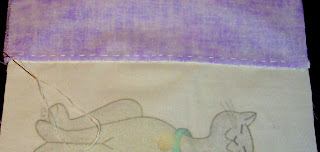
Here is my first sample piece of pojagi. I'm sure I didn't follow all the rules. I probably should have starched the fabric so it would hold it's shape. I used sheer hankies, old linens, some clip art and cat photos printed on fabric and the border is just plain cotton. I loved doing the handwork but it does take quite a bit of time. This piece wasn't planned ahead of time but I think I will plan my next piece using only sheer fabrics, so that there will be no front and back. Hope I've inspired some of you out there to try it.




